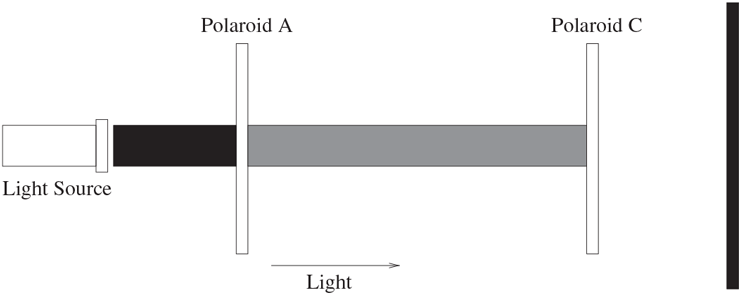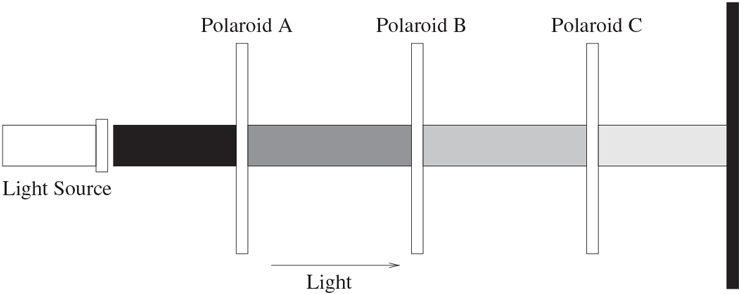25.1 A Quantum Experiment
Quantum mechanics is a difficult subject to explain to nonphysicists since it deals with concepts where our everyday experiences aren’t applicable. In particular, the scale at which quantum mechanical phenomena take place is on the atomic level, which is something that can’t be observed without special equipment. There are a few examples, however, that are accessible to us, and we now present one such example and use it to develop the mathematical formulation needed to describe some quantum computing protocols.
Since quantum mechanics is a particle-level physics, we need particles that we are able to observe. Photons are the particles that make up light and are therefore observable (similar demonstrations using other particles, such as electrons, can be performed but require more sophisticated equipment).
In order to understand this experiment better, we recommend that you try it at home. Start with a light source and three Polaroid® filters from a camera supply store or three lenses from Polaroid sunglasses.
Label the three filters , , and . Rotate them so that they have the following polarizations: horizontal, , and vertically, respectively (we will explain polarization in more detail after the experiment). Shine the light at the wall and insert filter between the light source and the wall as in Figure 25.1. The photons coming out of the filter will have horizontal polarization. Now insert filter as in Figure 25.2. Since filter has vertical polarization, it filters out all of the horizontally polarized photons from filter . Notice that no light arrives at the wall after this step, the two filters have removed all of the light components. Now for the final (and most bizarre) step, insert filter in between filter and . You should observe that there is now light arriving at the wall, as depicted in Figure 25.3. This is puzzling, since filter and were enough to remove all of the light, yet the addition of a third filter allows for light to reach the wall.
Figure 25.1 The Photon Experiment with Only Filter A Inserted

Figure 25.2 The Photon Experiment with Filters A and C Inserted

Figure 25.3 The Photon Experiment after All Filters Have Been Inserted

In order to explain this demonstration, we need to discuss the concept of polarization of light.
Light is an example of an electromagnetic wave, meaning that it consists of an electric field that travels orthogonally to a corresponding magnetic field. In order to visualize this, consider the light traveling along the -axis. Now imagine, for example, that the electric field is a wavelike function that lies in the -plane. Then the corresponding magnetic field would be a wavelike function in the -plane. For such a scenario, the light is referred to as vertically polarized. In general, polarization refers to the direction in which the electric field lies. There is no constraint on this direction.
We will represent a photon’s polarization by a unit vector in the two-dimensional complex vector space (however, for our present purposes, real numbers suffice). This vector space has a dot product given by , where and denote the complex conjugates of and . The square of the length of a vector is then . Choose a basis, which we shall denote and , for this vector space. We are choosing to use the ket (the second half of “bracket”) notation from physics to represent vectors. We can think of as being the vertical direction and as being horizontal. Therefore, an arbitrary polarization may be represented as , where and are complex numbers. Since we are working with unit vectors, the following property holds: . We could just have well chosen a different orthogonal basis, for example, one corresponding to a rotation: and .
The Polaroid filters perform a measurement of the polarity of the photon. There are two possible outcomes: Either the photon is aligned with the filter, or it is perpendicular to the direction of the filter. If the vector is measured by a vertical filter, then the probability that the photon has vertical polarity after passing through the filter is . The probability that it is measured as having horizontal polarity, and therefore not pass through, is .
Similarly, suppose we measure a vertically aligned photon with respect to a filter. Since
the probability that the photon passes through the filter (which means that it is measured as being aligned at ) is . Similarly, the probability that it doesn’t pass through the filter (which means that it is measured at ) is also .
One of the basic principles of quantum mechanics is that such a measurement forces the photon into a definite state. After being measured, the state of the photon will be changed to the result of the measurement. Therefore, if we measured the state of as , then, from that moment on, the photon will have the state . If we then measure this photon with a filter, we will always observe that the photon is in the state; however, if we measure with a filter, we will never observe that the photon is in the state.
Let’s now explain the interpretation of the experiment. The original light was emitted with random polarization, so only half of the photons being emitted will pass through the filter, and these photons will have their state changed to . The remaining half will be absorbed or reflected and will be changed to . When we place the vertical filter after the horizontal filter, the photons that hit it, which are in state , will be stopped.
When we insert filter in the middle, it corresponds to measuring with respect to , and hence those photons that had polarity will come out having polarity with probability . Therefore, there has been a reduction in the amount of photons passing through up to filter . Now the photons pass through the filter with probability also, and so the total intensity of light arriving at the wall is th the original intensity.
